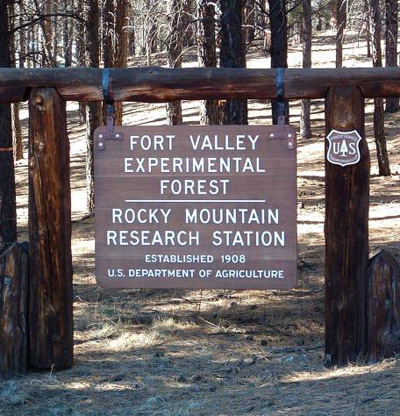Fort Valley Experimental Forest
 In December 1907, Forest Service Chief Gifford Pinchot requested that Raphael Zon, chief of the Division of Silvics, develop plans for permanent experiment stations devoted to scientific research on the national forests. The next year Zon traveled to Arizona, as Frank C.W. Pooler, the forest supervisor of Coconino National Forest in Arizona, suggested his forest as an ideal site for the first research location. Zon, Gustaf A. Pearson, and Willard Drake explored land on the Coconino, eventually selecting the area of Fort Valley, an isolated area near Flagstaff as the most suitable site.
In December 1907, Forest Service Chief Gifford Pinchot requested that Raphael Zon, chief of the Division of Silvics, develop plans for permanent experiment stations devoted to scientific research on the national forests. The next year Zon traveled to Arizona, as Frank C.W. Pooler, the forest supervisor of Coconino National Forest in Arizona, suggested his forest as an ideal site for the first research location. Zon, Gustaf A. Pearson, and Willard Drake explored land on the Coconino, eventually selecting the area of Fort Valley, an isolated area near Flagstaff as the most suitable site.
In August of 1908, the Coconino Experiment Station began operating as the first Forest Service research facility in the nation. Scientist Gustaf A. Pearson was selected to serve as the sites first director, a position he would hold until his retirement in 1944.
Renamed the Fort Valley Experiment Station in 1911, and later the Fort Valley Experimental Forest, the early years of the site saw significant research take place, even with severely limited funds and resources. Early research examined ponderosa pine forest management practices, as well as the effects of weather on seed regeneration.

Director's residence and office at Fort Valley Station, July 1911.
Civilian Conservation Corps workers helped expand the site's building, facilities, and permanent structures during the 1930s. During World War II, Fort Valley staff gave radio interviews promoting the importance of forest research on national resources in wartime.
During the 1950s, budget cuts and agency reorganization led to the decline in use of the Fort Valley site. The facilities were used intermittently over the subsequent years by outside groups, but more recent work by the USFS and Northern Arizona University have seen the site gain new importance. The Fort Valley campus is now listed on the National Register of Historic Places.
Additional Resources:
Olberding, Susan Deaver "Fort Valley: The Beginnings of Forest Research," from Forest History Today, Spring 2000. [PDF]

